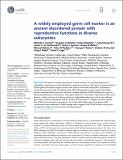| dc.contributor.author | Carmell, Michelle A | |
| dc.contributor.author | Dokshin, Gregoriy A | |
| dc.contributor.author | Skaletsky, Helen | |
| dc.contributor.author | Hu, Yueh-Chiang | |
| dc.contributor.author | van Wolfswinkel, Josien C | |
| dc.contributor.author | Igarashi, Kyomi J | |
| dc.contributor.author | Bellott, Daniel W | |
| dc.contributor.author | Nefedov, Michael | |
| dc.contributor.author | Enders, George C | |
| dc.contributor.author | Uversky, Vladimir N | |
| dc.contributor.author | Mello, Craig C | |
| dc.contributor.author | Reddien, Peter | |
| dc.contributor.author | Page, David C | |
| dc.date.accessioned | 2017-06-15T20:24:44Z | |
| dc.date.available | 2017-06-15T20:24:44Z | |
| dc.date.issued | 2016-10 | |
| dc.date.submitted | 2016-07 | |
| dc.identifier.issn | 2050-084X | |
| dc.identifier.uri | http://hdl.handle.net/1721.1/109922 | |
| dc.description.abstract | The advent of sexual reproduction and the evolution of a dedicated germline in multicellular organisms are critical landmarks in eukaryotic evolution. We report an ancient family of GCNA (germ cell nuclear antigen) proteins that arose in the earliest eukaryotes, and feature a rapidly evolving intrinsically disordered region (IDR). Phylogenetic analysis reveals that GCNA proteins emerged before the major eukaryotic lineages diverged; GCNA predates the origin of a dedicated germline by a billion years. Gcna gene expression is enriched in reproductive cells across eukarya – either just prior to or during meiosis in single-celled eukaryotes, and in stem cells and germ cells of diverse multicellular animals. Studies of Gcna-mutant C. elegans and mice indicate that GCNA has functioned in reproduction for at least 600 million years. Homology to IDR-containing proteins implicated in DNA damage repair suggests that GCNA proteins may protect the genomic integrity of cells carrying a heritable genome. | en_US |
| dc.description.sponsorship | Life Sciences Research Foundation | en_US |
| dc.description.sponsorship | Howard Hughes Medical Institute | en_US |
| dc.language.iso | en_US | |
| dc.publisher | eLife Sciences Publications, Ltd. | en_US |
| dc.relation.isversionof | http://dx.doi.org/10.7554/eLife.19993 | en_US |
| dc.rights | Creative Commons Attribution 4.0 International License | en_US |
| dc.rights.uri | http://creativecommons.org/licenses/by/4.0/ | en_US |
| dc.source | eLife | en_US |
| dc.title | A widely employed germ cell marker is an ancient disordered protein with reproductive functions in diverse eukaryotes | en_US |
| dc.type | Article | en_US |
| dc.identifier.citation | Carmell, Michelle A, Gregoriy A Dokshin, Helen Skaletsky, Yueh-Chiang Hu, Josien C van Wolfswinkel, Kyomi J Igarashi, Daniel W Bellott, et al. “A Widely Employed Germ Cell Marker Is an Ancient Disordered Protein with Reproductive Functions in Diverse Eukaryotes.” eLife 5 (October 8, 2016). | en_US |
| dc.contributor.department | Massachusetts Institute of Technology. Department of Biology | en_US |
| dc.contributor.mitauthor | Reddien, Peter | |
| dc.contributor.mitauthor | Page, David C | |
| dc.relation.journal | eLife | en_US |
| dc.eprint.version | Final published version | en_US |
| dc.type.uri | http://purl.org/eprint/type/JournalArticle | en_US |
| eprint.status | http://purl.org/eprint/status/PeerReviewed | en_US |
| dspace.orderedauthors | Carmell, Michelle A; Dokshin, Gregoriy A; Skaletsky, Helen; Hu, Yueh-Chiang; van Wolfswinkel, Josien C; Igarashi, Kyomi J; Bellott, Daniel W; Nefedov, Michael; Reddien, Peter W; Enders, George C; Uversky, Vladimir N; Mello, Craig C; Page, David C | en_US |
| dspace.embargo.terms | N | en_US |
| dc.identifier.orcid | https://orcid.org/0000-0002-5569-333X | |
| dc.identifier.orcid | https://orcid.org/0000-0001-9920-3411 | |
| mit.license | PUBLISHER_CC | en_US |
